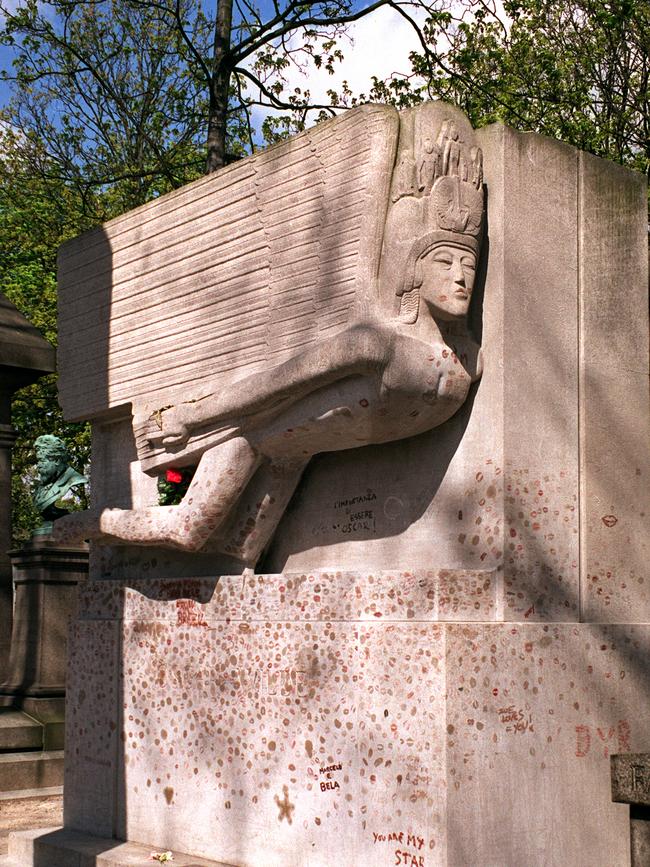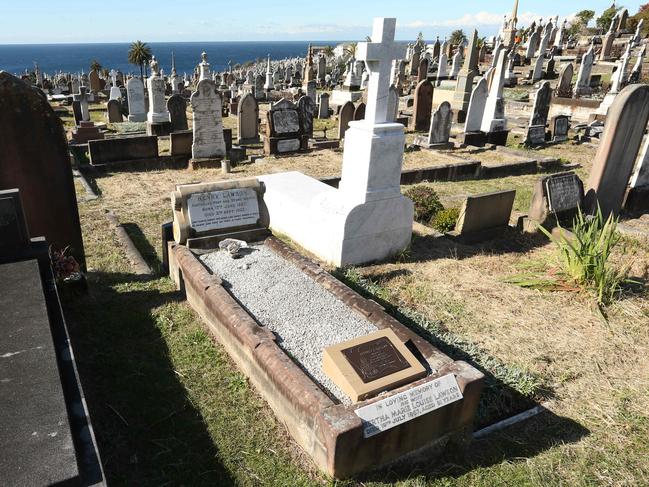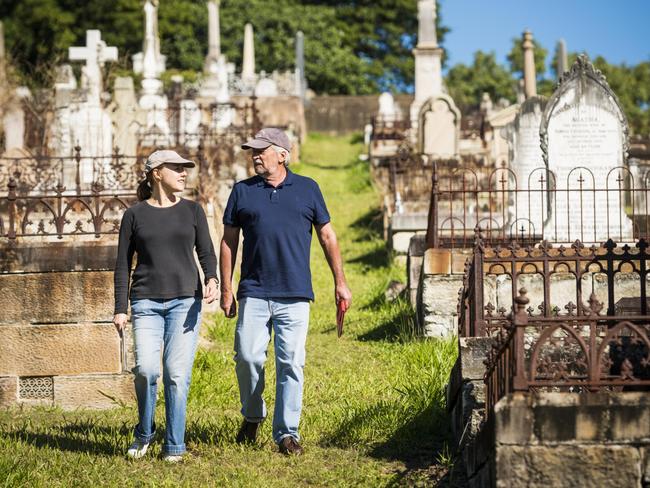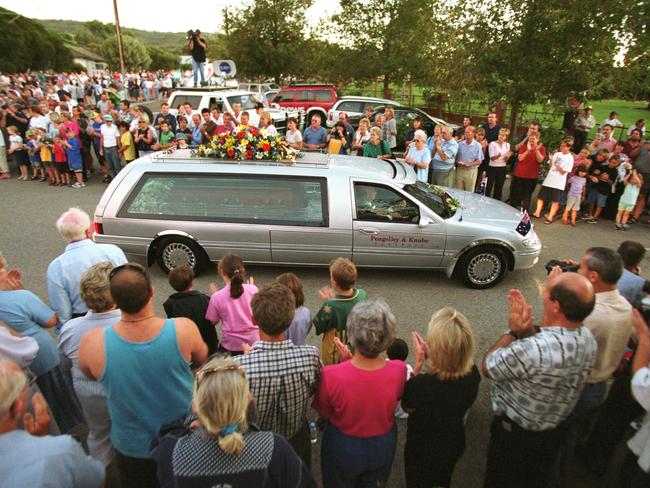Where famous Aussies are buried
From pop stars to prime ministers and sporting greats, the best deceased Australians are buried across the country. Here’s where you’ll find their final resting spots.
National
Don't miss out on the headlines from National. Followed categories will be added to My News.
There aren’t many tourist attractions that are both interesting and free. But cemeteries are, which might explain their popularity among Aussie travellers overseas, at least back in the day when flying long-distance was a thing.
How many budget-conscious Aussie backpackers traipsed out to Pere Lachaise cemetery in Paris to plant a smackeroo on Oscar Wilde’s tombstone, or look at the weird tributes left behind at Jim Morrison’s gravesite? How many ventured down to Bonaventure in Savannah, Georgia, because it was in Midnight in the Garden of Good and Evil? And how many paid their respects at the Old Jewish Cemetery in Prague, simply because it featured in an INXS video clip in the 1980s?
We’ll never know. A lot.
(Disclaimer: the writer of this story did all those things.)
Australian cemeteries seem to be less of a tourist drawcard than their overseas counterparts, despite some of them being stunningly picturesque.
Take Sydney’s Waverley Cemetery, for example. Perched on 41 quiet acres overlooking the Pacific Ocean, it may just be the most beautiful final resting place in the world.
The decaying monuments and overgrowth in our cemeteries have inspired many a fledgling photographer and first-year fashion student over the years.
But the mix of history and celebrity that draws the curious to Pere Lachaise doesn’t seem quite as strong at Australian grave sites.


There are exceptions, however. The tomb of Australia’s first saint Mary Mackillop in a dedicated chapel in Sydney’s St Leonards is a holy site for many Catholics, who come to pray and ask for her guidance.
Pilgrimages of a more secular kind are made to Michael Hutchence’s memorial at Sydney’s Northern Suburbs Memorial Park, and Bon Scott’s grave at Fremantle Cemetery in WA.
Fans are known to leave flowers (and sometimes booze in Bon’s case) and take selfies.
Graveyards are a great leveller in a way, putting the well-known together with the unknown, but the interred lists of some Australian cemeteries do seem to have themes, almost.
Melbourne General Cemetery boasts four Prime Ministers (James Scullin, Robert Menzies, John Gorton, Malcolm Fraser) plus a memorial to Harold Holt (whose body, of course, was never recovered), while Sydney’s Rookwood is a powerhouse of deceased Australian business identities, particularly in retail, with biscuit entrepreneur William Arnott, John Fairfax, John Gowings, Anthony Hordern, David Jones and Bing Lee all resting there.

Waverley has a more artistic bent, featuring the graves of Henry Lawson, Dorothea Mackellar, George Johnston and Henry Kendall, as well as Jules Archibald, the Bulletin founder after whom the famous portrait prize is named.
Our sporting greats are spread out everywhere. Don Bradman is in Adelaide’s Centennial Park Cemetery; Richie Benaud is in Sydney’s Eastern Suburbs Memorial Park; boxer Lionel Rose is in Warragul Cemetery, country Victoria; and Phar Lap strapper Tommy Woodcock is in Springvale Botanical Cemetery in Melbourne.
Many famous Australians have no grave sites to remember them.
Despite calling Australia home, Peter Allen’s ashes were scattered off the coast of California, while novelist Patrick White’s ashes became part of his beloved Centennial Park, and artist Brett Whiteley’s ashes were interred at Wendy Whiteley’s garden in Lavender Bay.
Musicians Chrissy Amphlett and Slim Dusty were also cremated, but their memories are treasured in other ways: Amphlett Lane in Melbourne’s CBD was named after the Divinyls lead singer, while the statue “The Cunnamulla Fella” stands in outback Queensland in honour of the much-loved country singer-songwriter.
For Brisbane-based writer Chris Adams, it’s not so much the stories of the infamous or the famous lying in Australian cemeteries that interests him. It’s the lesser-known stories connected to ordinary people.
With partner Helen Goltz, Adams has penned the Grave Tales series of books, uncovering incredible but true stories from Australian graveyards.
Asked which Australian cemetery holds the most interest, he said “they’re all different” but nominated Camperdown Cemetery in Sydney’s inner west as a favourite.
“It’s a place where the dead mingle with the living,” he said.
“It’s not a cut-off place with big walls. It’s a place of some remarkable Sydney stories, like the sinking of the Dunbar, which is probably the greatest tragedy the place ever had. People were smashed about in the waters below South Head so badly that many of them couldn’t be recognised, and they’re buried in a mass grave in Camperdown.”

But all Australian cemeteries have their secrets, Adams said.
He described the Isle of the Dead off Tasmania’s Port Arthur as “a must-do for cemetery freaks”, while Geelong Eastern Cemetery and Toowong Cemetery in Brisbane do a particularly good job of telling the history of those buried within.
While Fawkner Cemetery in Melbourne may have gained a reputation for the number of criminals it holds, Adams said “you will also find heaps of other great stories in Fawkner”.
“A lot of people don’t know that the first mid-air collision between RAAF aircraft was in 1927, when the Duke and Duchess of York were over here as the British representatives for the opening of Parliament House in Canberra,” he said.

“There was a fly past in Melbourne and two of them bumped together and crashed. One of the pilots who was killed is buried in Fawkner. The Duke saw it happen.”
It is almost as if our history gets buried along with our dead – something that Adams said happens “all the time”.
“The one thing you see when you do what we do is the number of great people for whom there is so little to remember them by.”

The gravesite of Ben Lexcen, whose “winged keel” yacht design helped Australia win a historic victory over the US in the America’s Cup in 1983, is a case in point, Adams said.
“Here was a bloke who [Bob] Hawke said was a great Australian, and he’s buried in Frenchs Forest Bushland Cemetery, and he’s got this tiny little marker for where his ashes are,” Adams said.
“I feel like I want to get a big stick with a sign saying ‘This is Ben Lexcen here, have a look.”
Cemetery authorities themselves can sometimes be unaware of the historical significance of the people they have interred.


Mark Bundy, chief “gravesite technician” at Sydney’s Rookwood, said it is often only through the descendants of the deceased that the cemetery uncovers its own buried histories.
A classic example of this happened just recently. William Tipple Smith died in poverty with an unmarked final resting place in Rookwood Cemetery. But he was also the first person to strike gold in NSW in 1848 – three years before the discoveries near Bathurst set off the country’s first gold rush. Smith was also a pioneer of the steel and iron industry in Australia.
Thanks to a family history – and subsequent donations from corporations, the NSW government and the public – Smith was finally given a memorial befitting his significance in September. History has been rewritten.
“We’re finding out stuff all the time,” Mr Bundy said.
“You’ve got to follow the story all the way through. Having the time to do it all would be fantastic.
“We’ve had a million internments, and we say there’s a million stories at Rookwood. People ask ‘Who’s the most famous person buried here?’ I say there’s a million famous people buried here, not one person. Everyone’s got a story.”
More Coverage
Originally published as Where famous Aussies are buried





